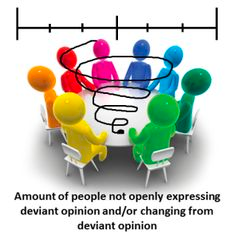THE SPIRAL OF SILENCE THEORY
The Spiral of Silence Theory is a communication theory proposed by German political scientist Elisabeth Noelle-Neumann in 1974. The theory explains how public opinion is formed and how it affects individuals' willingness to speak up or remain silent on certain issues. It is based on the idea that people have a natural tendency to seek acceptance and approval from others, and that this desire can lead to the suppression of unpopular opinions.
Noelle-Neumann argues that individuals are constantly monitoring their social environment to determine which viewpoints are popular and what opinions are not. People are more prone to keep quiet when they believe their opinion is in the minority because they are afraid of being rejected or socially isolated. On the other hand, people are more willing to speak up when they believe their viewpoint is shared by the majority because they feel more confident and secure in their position.
You can visualize the spiral effect in the image to the left. The spiral effect unfolds as a result of people's impressions on the dominant public opinion which then influences their next actions and in turn influences other people's perceptions too. As more people remain silent on a particular issue, the perception that the majority supports the dominant opinion becomes even stronger. This sets up a vicious loop that can result in the restriction of free expression and the exclusion of minority viewpoints.This Spiral of Silence Theory is often used to explain why certain issues may not receive the attention they deserve or why some people may not speak up on important matters. For example, a person who holds a controversial opinion may choose to remain silent for fear of being ostracized by their social group. Alternatively, a person may publicly express a popular opinion that they do not actually hold, for fear of social isolation or backlash. The theory has also been used to explain why some people may choose not to vote, as they feel that their vote will not make a difference in the in the face of a dominant public opinion.
Pew Research Center also did a study using 1,801 adults testing the Spiral of Silence Theoryand how it is relevant with social media. The study concluded that "in both personal and online settings, people were more willing to share their views if they thought their audience agreed with them." We see this a lot with social media, not only with certain opinions, but also with people only posting pictures not of their own liking, but for what they think other people will accept and consider to be 'okay' in society and what content will receive the most likes based on their following audience. This is all surrounded by a significant source of fear and anxiety that people have because of our natural need for social validation and acceptance from others. Certain news channels and reporters will also only share information that they feel their audience will like to listen to even if it is not necessarily true or the more right opinion.
One practical implication of the Spiral of Silence Theory is that it emphasizes the importance of creating safe spaces for individuals to express their opinions. We need to start encouraging open dialogue, and creating a culture of respect and inclusivity. By creating an environment where all voices are valued, individuals may feel more comfortable expressing their opinions, even if they are in the minority. The Spiral of Silence Theory remains a valuable framework for understanding how public opinion is shaped and how individuals can be empowered to express their opinions. By creating a culture of respect and inclusivity, we can help ensure that all voices are heard and that minority opinions are not marginalized.







No comments:
Post a Comment